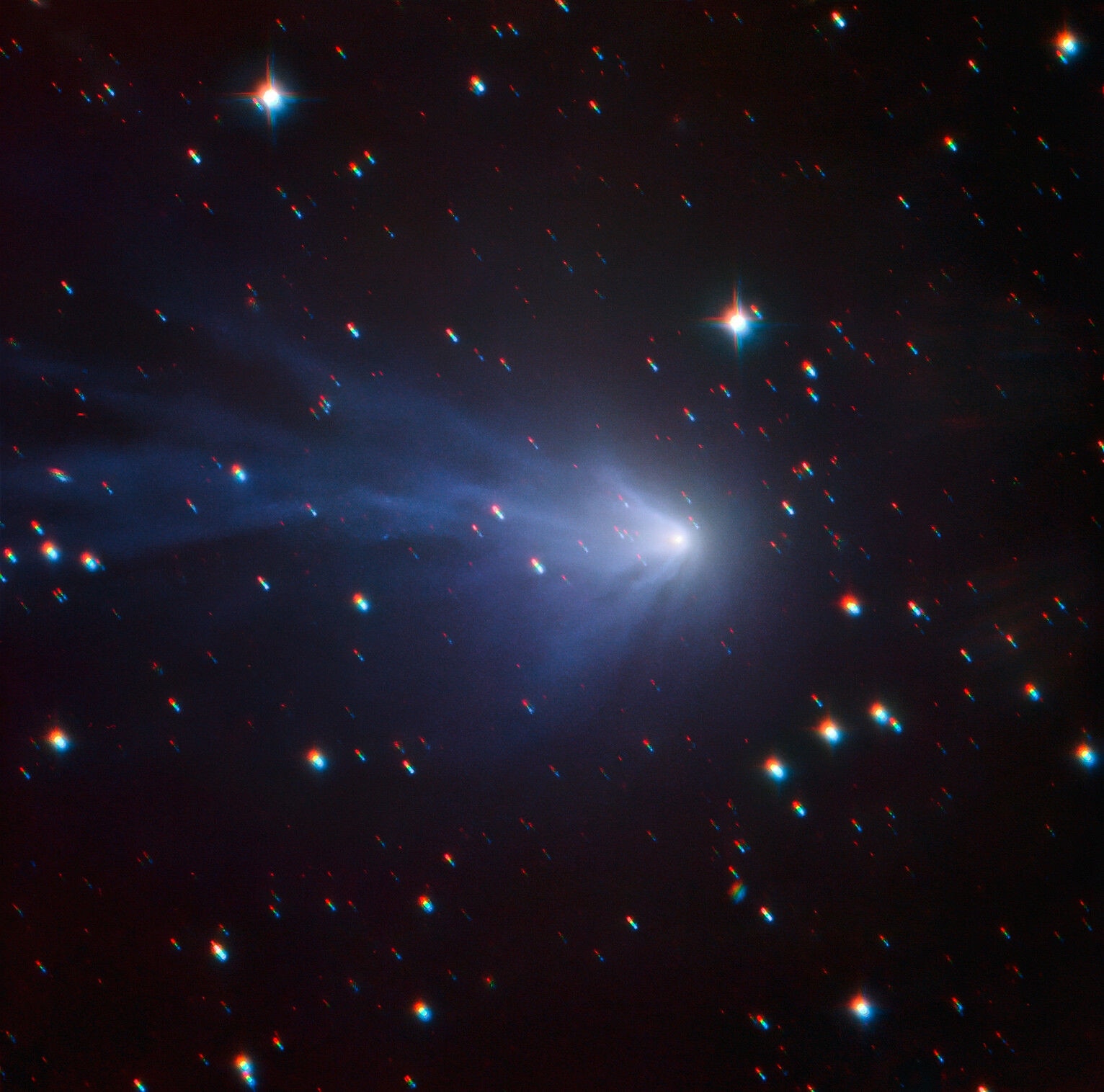Create a free profile to get unlimited access to exclusive videos, sweepstakes, and more!
C/2016 R2 (Pan-STARRS): When a comet blue by

Comets are lovely. Giant chunks of ice, rock, and dust, they tend to orbit the Sun on long, elliptical paths, and when they get near our star they heat up, releasing gas and dust into space. These form two kinds of tails. One is made of dust, which slowly moves away, each grain on its own orbit, lagging behind the comet on its path as they are slowly pushed by the whisper light pressure of sunlight.
The other is made of gas, formed from ices on or just beneath the comet's surface. This material gets ionized by ultraviolet light from the Sun — electrons are stripped off the molecules. This makes them susceptible to the electrically charged solar wind screaming past them at hundreds of kilometers per second, blowing the ion tail straight back from the Sun.
Many comets sport both kinds of tails. And then there's the comet C/2016 R2 (Pan-STARRS), discovered in Pan-STARRS images on 7 September, 2016. It was remarkable for many reasons, but this image should relay that info nicely.
Wow! It's really blue (and not just colored that way for the image). The gas tails of comets are generally green, due to the molecule C2, two carbon atoms bound together. That's common in comets; while the molecule isn't hugely abundant, it shines very brightly when excited by sunlight. Other molecules glow in various colors, but green tends to dominate.
But not in 2016 R2! The blue color is coming from molecules of carbon monoxide (CO) with a single electron removed (so, CO+). In fact, while it was still 450 million kilometers from the Sun — three times Earth's distance from the Sun — this completely dominated the emission, making the comet glow blue. That's very unusual.
It was also rich in nitrogen*, which is unusual for comets as well. On top of that it was depleted in the usual stuff we see in comets, like water, carbon dioxide, hydrogen cyanide, and the like. So that's weird.
Even weirder? No dust! Like, so little it couldn't be detected. This comet was all gas, no dust.
It gets weirder yet. The comet has an orbit about 21,000 years long. That's a long time for humans, but very short compared to the age of the solar system. The comet has passed the Sun likely thousands of times in its life. What's weird about that is that gases like CO+ tend to be very volatile; in other words they leave the comet very vigorously when the comet is warmed by sunlight. 2016 R2 was producing up to ten tons of this per second at its closest point to the Sun, which is pretty high. How can it have any left?
Maybe it was once much bigger. It's less than 15 kilometers across now, but it might have been much bigger in the past. But even then, the fact that it has so much compared to other ices is really odd. Astronomers postulate it may have formed very far out from the Sun, where temperatures are very cold; at those distances nitrogen and CO can form in objects more easily.
Or — and I love this idea — it may have been a chunk blasted off a much larger body out past Neptune. These are called Trans Neptunian Objects, and that's a general term for the rocky/icy bodies in the outer solar system. They can be quite large, so big that their gravity may have actually allowed heavier materials like rock to sink to their cores while they were still forming and still liquid, and lighter stuff like ices float to the surface. A big impact could then dislodge a piece of this lighter material, making comets like 2016 R2.
Coooool. Literally.
2016 R2 was unusually active as well. The first image above shows how complex the tail was. That's likely due to outbursts from the comet — pockets of ice suddenly exposed to sunlight and sublimating (turning directly to gas) rapidly coupled with fluctuations in the solar wind. It was taken by master astrophotographer Damian Peach on 16 January 2018. But then literally four nights later he took this shot of the same comet:
What the what? All those long curls in the tail are due to outgassing coupled this time with the comet's rotation. The solid part of a comet, called the nucleus, spins, so over time you get those corkscrew features, like a lawn sprinkler apparently making spirals as it spins and shoots water out. If the sprinkler also moved across your lawn as well then you'd get very similar features.
Incidentally, observations from other astronomers showed shells of gas very close in to the nucleus, indicating sudden outgassing as well. This comet is very active (note that the second image above is from SPECULOOS, an observatory in the southern hemisphere, and was taken on 18 January, in between both of Peach's, yet it looks completely different; this comet was changing on an almost hourly basis). I wonder what it would look like if it got closer to the Sun?
We'll never know, really. It won't be back this way for another 21 centuries at least, and when it does it won't get much closer than 400 million kilometers. And this kind of comet is very rare; only a handful of comets seen in the past century have exhibited these sorts of characteristics.
Famed comet hunter David Levy once said, "Comets are like cats: They have tails, and they do precisely what want." Unlike cats, though, which laze in sunlight, comets get more active. But with both, predicting what they'll be like is still very, very tough.
*This paper, authored by Cochrane and McKay, sounds like the greatest Star Trek/Stargate crossover ever… but it was Anita and Adam, not Zephram and Rodney.





























